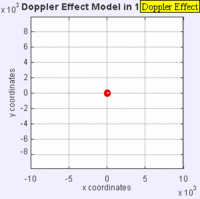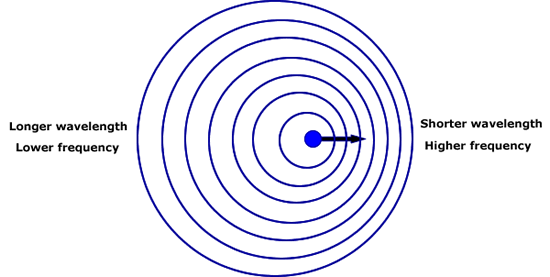The Doppler Effect - The Physics
Whether many years ago, daydreaming in Physics class, or last night, courtesy of pop-culture scientist Sheldon Cooper, chances are you have heard of the Doppler effect. It's the reason a passing ambulance produces a sound of fluctuating pitch, and why you can tell if an overhead airplane is moving towards or away from you even on an overcast day. But how does the famous phenomenon work?
To understand this effect, we must look at the nature of sound. Sound travels (propagates) in waves, much like ripples over the surface of a pond. When a source produces sound waves, these waves propagate in every direction, and the distance between each wavefront, or the distance from peak-to-peak/trough-to-trough, is termed its wavelength.
So how does this tie in to the Doppler effect? The 'pitch' of a sound (how high or low a listener perceives the sound to be) is dictated by a wave's frequency - that is, the number of full wavelength distances propagated per second. A sound wave with a frequency of 1 Hz (the unit of frequency, pronounced 'Hertz') completes one full cycle, and advances one full wavelength, each second.
Frequency is related to both the speed of the wave propagation and the wavelength of the waves; this relationship can be written in the form frequency = speed/wavelength. For a source that is stationary relative to the listener, such as the alarm of a parked car, this frequency remains constant, since both the speed of the wave (343 metres per second) and the distance between each wavefront is fixed. As such, the pitch of the waves heard by a listener in any direction remains constant. The propagation of waves from the car alarm can be visualised as below:

It is important to note here that a source of sound waves emits with a constant frequency, even when moving. In other words, the 'change in pitch' we are about to explain is not the result of the source's wave frequency changing, but the change in perceived frequency of the waves meeting the listener due to their relative speeds.
This may sound complicated, but another visual aid helps:

Notice that the sound waves in front of the moving source are 'bunched'. Here, the distance between wavefronts is much shorter than behind the source, where the waves appear 'stretched'. If we take the source at any instant (see the figure below), we may draw two conclusions. Firstly, the source frequency remains constant - for every wavefront behind the source there is a joined wavefront ahead of the source, and each wave-circle is fully formed without breaks. To reiterate, it is not the source frequency, but the differing areas within which the waves propagate that leads to this change of wavelength. Secondly, the result of this wavelength change is to increase the number of wavefronts per second approaching the listener ahead of the source (rewatch the animation to check!) and decrease the number met by a listener behind the source.

We defined frequency to be the number of wavefronts travelled per second, so this must mean that the perceived frequency of the sound heard by the listener ahead of the source is greater than that heard by the listener behind it. This explains why an ambulance siren increases in pitch as it approaches you (and you are ahead of it) and decreases as it moves away (and you are behind it).
This phenomenon is not limited to sound waves! Electromagnetic waves such as visible light and radio waves also undergo Doppler shift with a moving source. Photographs of celestial bodies taken by equipment such as the Hubble Space Telescope have to undergo colour correction to account for a type of Doppler effect called red shift.

Distant galaxies are accelerating away from our own, and so the visible part (of wavelength 390 - 700 nanometers) of their emitted electromagnetic radiation is 'stretched' in wavelength. This increase in wavelength corresponds to a shift towards the red end of the visible range, hence the term 'red shift'.

You may be wondering: 'why doesn't a car moving away from me in the street change colour?'
Light waves propagate much faster than sound waves (about 880,000 times the speed!) and so the source must be moving tremendously quickly to appreciably affect the relative velocity of each sound wave.
So unlike its commonplace sound-wave counterpart, electromagnetic Doppler shift is, in everyday life, virtually imperceptible.
For more on sound wave phenomena, try my article on shock waves and 'sonic booms': https://steemit.com/science/@cjrc97/breaking-the-sound-barrier-the-physics
References:
https://goo.gl/F4qFsH
https://giphy.com/search/doppler-effect
https://goo.gl/8fmSTS
https://goo.gl/EfgUGR
https://goo.gl/XoLB6t
Get More Upvotes and Followers : https://steemfollower.com/?r=1966
good post, I would like to know what will happen if you were moving faster than the speed of sound and entering the sound barrier, imagine that you are moving in a car at 1000 m/s if you would calculate the Doppler effect equation the frequency will be negative (because 340-1000=-660) what would the person on the street hear when that car pass beside him ?
My next article will be up shortly. It discusses shock waves, so hopefully it will answer your question about what happens 'beyond the sound barrier'. Stay tuned!
Edit: https://steemit.com/science/@cjrc97/breaking-the-sound-barrier-the-physics
This post has received a 5.56 % upvote from @buildawhale thanks to: @trumpman. Send 0.100 or more SBD to @buildawhale with a post link in the memo field to bid on the next vote.
To support our curation initiative, please vote on my owner, @themarkymark, as a Steem Witness
Join us on #steemSTEM / Follow our curation trail on Streemian
Thank you for this very interesting article. It has been advertised on our chat channel (and upvoted).
The steemSTEM project is a community-supported project aiming to increase the quality and the visibility of STEM (STEM is the acronym for Science, Technology, Engineering and Mathematics) articles on Steemit.
Thank you - a follow-up article on shock waves is up next!
https://steemit.com/science/@cjrc97/breaking-the-sound-barrier-the-physics